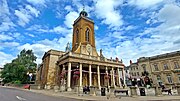
Back Northampton AN نورثامبتون Arabic نورثهامبتون ARZ Northampton AST Northempton Azerbaijani نورثهمپتون AZB Нартгемптан Byelorussian Нортгэмптан BE-X-OLD Нортхамптън Bulgarian Northampton Catalan
| Northampton | |
|---|---|
| Town and civil parish | |
Clockwise from top: Northampton Guildhall; All Saints' Church; Market Square; Abington Park and; the National Lift Tower | |
Location within Northamptonshire | |
| Population | 249,093 (2021 census)[1] |
| Civil parish |
|
| Unitary authority | |
| Ceremonial county | |
| Region | |
| Country | England |
| Sovereign state | United Kingdom |
| Areas of the town | List
|
| Post town | NORTHAMPTON |
| Postcode district | NN1—NN7 |
| Dialling code | 01604 |
| Police | Northamptonshire |
| Fire | Northamptonshire |
| Ambulance | East Midlands |
| UK Parliament | |
Northampton (/nɔːrˈθæmptən/ ⓘ nor-THAMP-tən) is a town and civil parish[2] in the West Northamptonshire unitary authority area[3] of Northamptonshire, England. It is the county town of Northamptonshire and the administrative centre of the unitary authority of West Northamptonshire. The town is situated on the River Nene, 60 miles (97 km) north-west of London and 50 miles (80 km) south-east of Birmingham. Northampton is one of the largest towns in England;[4] the population of its overall urban area was recorded as 249,093 in the 2021 census.[1] The parish of Northampton alone had 137,387.[5]
Archaeological evidence of settlement in the area dates to the Bronze Age, Romans and Anglo-Saxons. In the Middle Ages, the town rose to national significance with the establishment of Northampton Castle, an occasional royal residence which regularly hosted the Parliament of England. Medieval Northampton had many churches, monasteries and the University of Northampton, all enclosed by the town walls. It was granted a town charter by Richard I in 1189 and a mayor was appointed by King John in 1215. The town was also the site of two medieval battles, in 1264 and 1460.
The town largely supported the Parliamentary Roundheads during the English Civil War, which prompted Charles II to order the destruction of the town walls and most of the castle. The Great Fire of Northampton in 1675 also destroyed much of the historic town. Northampton was soon rebuilt and grew rapidly with the industrial development of the 18th century. The town continued to expand with the arrival of the Grand Union Canal and the railways in the 19th century, becoming a centre for footwear and leather manufacture.
Growth was limited following the World Wars until it was designated a New Town in 1968, accelerating development which has continued into the 21st century. Northampton unsuccessfully applied for city status four times; in 1992, 2000, 2002 and 2022.[6]
- ^ a b "UNITED KINGDOM: Countries and Major Urban Areas". citypopulation.de. City Population. Retrieved 11 March 2024.
- ^ "Northampton". Ordnance Survey. Retrieved 22 October 2020.
- ^ "About West Northamptonshire Council | West Northamptonshire Council". www.westnorthants.gov.uk. Retrieved 4 October 2024.
- ^ "Britain's 20 biggest towns". The Daily Telegraph. London. 18 August 2011. Archived from the original on 11 January 2022.
- ^ "Northampton". City Population. Retrieved 8 December 2024.
- ^ Mead, Nick Van (18 January 2015). "How UK cities compare for population, jobs, new businesses and house prices". The Guardian.





